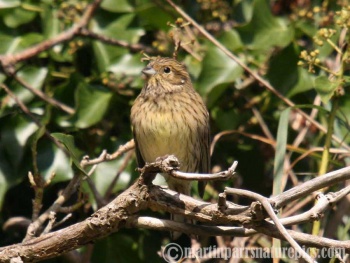(Video link and photo of female uploaded. Some extra information added) |
|||
| Line 16: | Line 16: | ||
The preferred habitat is warm, dry scrubland and low-intensity agriculture with small fields and numerous hedges with scattered large trees for song perches; also uses large gardens close to farmland. | The preferred habitat is warm, dry scrubland and low-intensity agriculture with small fields and numerous hedges with scattered large trees for song perches; also uses large gardens close to farmland. | ||
==Behaviour== | ==Behaviour== | ||
| − | Flocks with other seed-eaters, especially [[Yellowhammer]]s | + | Flocks with other seed-eaters, especially [[Yellowhammer]]s. |
====Flight==== | ====Flight==== | ||
| − | Hops. A rather bounding flight | + | Hops. A rather bounding flight. |
====Diet==== | ====Diet==== | ||
The diet includes insects and seeds. | The diet includes insects and seeds. | ||
Revision as of 18:19, 21 March 2009

- Emberiza cirlus
Identification
15-16.5cm. Male Cirl Buntings have diagnostic black and yellow faces. The females show hints of this same black and yellow pattern including obvious broad dark lines behind and below the eye.
Similar Species
If you are in doubt about whether you have a Cirl Bunting or a Yellowhammer, check the rump colour - grey brown on a Cirl Bunting, almost red on a Yellowhammer. Also, Cirl Buntings have a small grey shoulder patch and richer chestnut on the upperparts.
Distribution
Common in the south-west of the Western Palearctic, breeds from Iberia and Morocco north to most of France, the extreme south of England (southern Devon) and southwest Germany, and east to southern Romania and northeast Turkey. It is resident throughout its range, with no migratory populations.
Extralimital records are rare, with only a handful of records north to Scotland, the Netherlands, Denmark, Poland and the Ukraine, and south to the Canary Islands and Egypt.
Taxonomy
There are 2 subspecies.
Habitat
The preferred habitat is warm, dry scrubland and low-intensity agriculture with small fields and numerous hedges with scattered large trees for song perches; also uses large gardens close to farmland.
Behaviour
Flocks with other seed-eaters, especially Yellowhammers.
Flight
Hops. A rather bounding flight.
Diet
The diet includes insects and seeds.
Breeding
The nest is placed in a hedge or bush, and the eggs are incubated for 14 days. There can be 2 or 3 broods.
Vocalisation
Call "zit"
<flashmp3>Emberiza cirlus (song).mp3</flashmp3>
Listen in an external program
References
- ARKive
- Collins Pocket Guide to British Birds 1966
External Links




